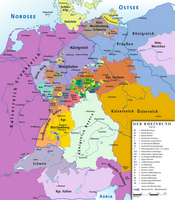| This article does not cite any sources. Please help improve this article by adding citations to reliable sources. Unsourced material may be challenged and removed. Find sources: "Reuss-Lobenstein" – news · newspapers · books · scholar · JSTOR (May 2022) (Learn how and when to remove this message) |
| Lordship (County, Principality) of Reuss-LobensteinHerrschaft (Grafschaft, Fürstentum) Reuß-Lobenstein | |||||||||||||
|---|---|---|---|---|---|---|---|---|---|---|---|---|---|
| 1425–1547 1647–1824 | |||||||||||||
 Flag
Flag
 Coat of arms
Coat of arms
| |||||||||||||
 The Reuss Junior Line within Thuringia The Reuss Junior Line within Thuringia | |||||||||||||
| Status | State of the Holy Roman Empire, then State of the Confederation of the Rhine | ||||||||||||
| Capital | Neundorf bei Lobenstein | ||||||||||||
| Government | Principality | ||||||||||||
| Historical era | Early Modern Age | ||||||||||||
| • Partitioned from Reuß-Gera | 1425 | ||||||||||||
| • Annexed to Reuß-Plauen | 1547 1425 | ||||||||||||
| • Re-created by partition from Reuß-Schleiz | 1647 | ||||||||||||
| • Raised to county | 1673 | ||||||||||||
| • Partitioned to create Reuß-Hirschberg and Reuß-Ebersdorf | 1678 | ||||||||||||
| • Partitioned to create Reuß-Selbitz | 1710–1805 | ||||||||||||
| • Raised to principality | 1790 1824 | ||||||||||||
| • Inherited by R-Ebersdorf | 1824 | ||||||||||||
| |||||||||||||
Reuss-Lobenstein (German: Reuß-Lobenstein) was a state located in the German part of the Holy Roman Empire.
History

The members of Reuss-Lobenstein family belonged to the Reuss Junior Line. Reuss-Lobenstein has existed on two occasions, it was firstly created in 1425 as a lordship with Heinrich II, Lord of Reuss-Lobenstein becoming the first ruler. The first Lordship of Reuss-Lobenstein came to an end in 1547 when the territory went to Reuss-Plauen.
Reuss-Lobenstein was recreated in 1647 again as a lordship which it remained until 1673 when the title of lord was upgraded to count. Following the death of Count Henry X in 1671, Reuss-Lobenstein was ruled jointly by his three sons Heinrich III, Heinrich VIII and Heinrich X. In 1678 Reuss-Lobenstein was partitioned with Heinrich III remaining Count of Reuss-Lobenstein, Heinrich VIII becoming Count of Reuss-Hirschberg and Heinrich X becoming the Count of Reuss-Ebersdorf. Reuss-Lobenstein was partitioned for a second time in 1710 following the death of Heinrich III with Reuss-Selbitz being created for a younger son Heinrich XXVI while his eldest son Heinrich XV succeeded him as count of Reuss-Lobenstein.
Reuss-Lobenstein was raised to a principality in 1790 and joined the Confederation of the Rhine on 15 December 1806. With the death of Prince Heinrich LIV in 1824 the Reuss-Lobenstein line became extinct and was inherited by the Prince of Reuss-Ebersdorf.
Rulers of Reuss-Lobenstein
Lords of Reuss-Lobenstein, 1425–1547
- Heinrich II, 1425–70
- Heinrich I, 1482–87
- Heinrich II, 1482–1500, with
- Heinrich III, 1482–1498
- Heinrich I, 1500–38, with
- Heinrich II, 1500–1547
To Reuss-Plauen, 1547
Lords of Reuss-Lobenstein 1647–1673
- Heinrich X, 1647–71
- Heinrich III, 1671–1710, with
- Heinrich VIII, 1671–73 and
- Heinrich X, 1671–73
Raised to county, 1673
Counts of Reuss-Lobenstein (1673–1790)
- Heinrich III, 1673–1710, with
- Heinrich VIII (count of Reuss-Hirschberg from 1678), 1673–78 and
- Heinrich X (count of Reuss-Ebersdorf from 1678), 1673–78
- Heinrich XV, 1710–39
- Heinrich II, 1739–82
- Heinrich XXXV, 1782–90
Raised to principality, 1790
Princes of Reuss-Lobenstein (1790–1824)
- Heinrich XXXV, 1790–1805
- Heinrich LIV, 1805–24
To Reuss-Ebersdorf, 1824
| Electorates |  | |
|---|---|---|
| Ecclesiastical | ||
| Secular | ||
| Prelates | ||
| Counts / Lords | ||
| Circles est. 1500: Bavarian, Swabian, Upper Rhenish, Lower Rhenish–Westphalian, Franconian, (Lower) Saxon Circles est. 1512: Austrian, Burgundian, Upper Saxon, Electoral Rhenish · Unencircled territories See also: Ernestine duchies | ||
| States of the Confederation of the Rhine (1806–1813) | ||||||||
|---|---|---|---|---|---|---|---|---|
| Rank elevated by Napoleon |
|  | ||||||
| States created |
| |||||||
| Pre-existing states |
| |||||||
| ||||||||
Categories:
- Imperial County of Reuss
- States of the Confederation of the Rhine
- 1547 disestablishments in the Holy Roman Empire
- Upper Saxon Circle
- States and territories established in 1647
- States and territories established in 1425
- 1420s establishments in the Holy Roman Empire
- 1425 establishments in Europe
- 1647 establishments in the Holy Roman Empire
- 1824 disestablishments in the German Confederation